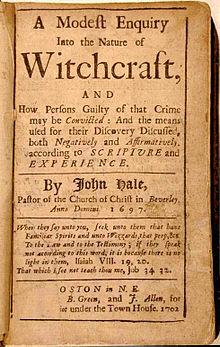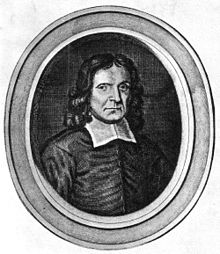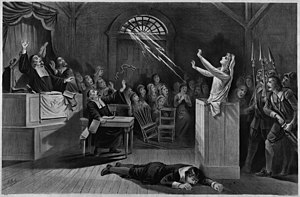Traveling within the World
Linking your favorite traveling artists across the globe
Reversals of attainder and compensation to the survivors and their families

The first hint that public call for justice was not over happened in 1695, when Thomas Maule, a noted Quaker, publicly criticized the handling of the trials by the Puritan leaders in Chapter 29 of his book Truth Held Forth and Maintained, expanding on Increase Mather by stating, "it were better that one hundred Witches should live, than that one person be put to death for a witch, which is not a Witch". For publishing this book, Maule was imprisoned twelve months before he was tried and found not guilty.

On December 17, 1696, the General Court ruled that there would be a fast day on January 14, 1697, "referring to the late Tragedy, raised among us by Satan and his Instruments." On that day, Samuel Sewall asked Rev. Samuel Willard to read aloud his apology to the congregation of Boston's South Church, "to take the Blame & Shame" of the "late Commission of Oyer & Terminer at Salem".Thomas Fiske and eleven other trial jurors also asked forgiveness.
Robert Calef, a merchant in Boston and long-time public adversary of Cotton Mather, republished Cotton Mather's Wonders of the Invisible World in 1700 with additional material added to it, broadly criticizing the proceedings, under the title More Wonders of the Invisible World, bringing the issue back into public debate. John Hale, a minister in Beverly who was present at many of the proceedings, had completed his book, A Modest Enquiry into the Nature of Witchcraft in 1697, but it wasn't published until 1702, after his death, and perhaps in response to Calef's book. Expressing regret over the actions taken, Hale admitted, "Such was the darkness of that day, the tortures and lamentations of the afflicted, and the power of former presidents, that we walked in the clouds, and could not see our way."
Various petitions were filed between 1700 and 1703 with the Massachusetts government, demanding that the convictions be formally reversed. Those tried and found guilty were considered dead in the eyes of the law, and with convictions still on the books, those not executed were vulnerable to further accusations. The General Court initially reversed the attainder only for those who had filed petitions, only three people who had been convicted but not executed: Abigail Faulkner Sr., Elizabeth Proctor, and Sarah Wardwell. In 1703, another petition was filed, requesting a more equitable settlement for those wrongly accused, but it wasn't until 1709, when the General Court received a further request, that it took action on this proposal. In May 1709, 22 people who had been convicted of witchcraft, or whose relatives had been convicted of witchcraft, presented the government with a petition in which they demanded both a reversal of attainder and compensation for financial losses.

Repentance was evident within the Salem Village church. Rev. Joseph Green and the members of the church voted on February 14, 1703, after nearly two months of consideration, to reverse the excommunication of Martha Corey. On August 25, 1706, when Ann Putnam Jr., one of the most active accusers, joined the Salem Village church, she publicly asked forgiveness. She claimed that she had not acted out of malice, but was being deluded by Satan into denouncing innocent people, and mentioned Rebecca Nurse in particular, and was accepted for full membership.
On October 17, 1711, the General Court passed a bill reversing the judgment against the 22 people listed in the 1709 petition (there were seven additional people who had been convicted but had not signed the petition, but there was no reversal of attainder for them). Two months later, on December 17, 1711, Governor Joseph Dudley also authorized monetary compensation to the 22 people in the 1709 petition. The amount of 578 pounds 12 shillings was authorized to be divided among the survivors and relatives of those accused, and most of the accounts were settled within a year, but Phillip English's extensive claims weren't settled until 1718.
Finally, on March 6, 1712, Rev. Nicholas Noyes, and members of the Salem church reversed Noyes' earlier excommunications of their former members, Rebecca Nurse and Giles Corey.
Memorials by descendants
Rebecca Nurse's descendants erected an obelisk-shaped granite memorial in her memory in 1885 on the grounds of the Nurse Homestead in Danvers, with an inscription from Whittier. In 1892 an additional monument was erected in honor of 40 neighbors who signed a petition in support of Nurse.
Not all the condemned had been exonerated in the early 18th century, and so in 1957, descendants of the six people who had been wrongly convicted and executed but who had not been included in the bill for a reversal of attainder in 1711, or added to it in 1712, demanded that the General Court formally clear the names of their ancestral family members. An act was passed pronouncing the innocence of those accused, although it listed only Ann Pudeator by name. The others were listed only as "certain other persons," phrasing which failed specifically to name Bridget Bishop, Susannah Martin, Alice Parker, Wilmot Redd and Margaret Scott.
Trials-related family-history groups offer places where descendants can memorialize their ancestors while sharing ideas and information about their research. The Associated Daughters of Early American Witches was founded in 1987 in California. It invites members who are women and able to prove descent from an ancestor who was accused of witchcraft including those at the Salem trials. Bloodlines of Salem was founded in 2007 in Utah. It welcomes members who are able to prove descent from a trials participant or who choose simply to support the group.

The 300th anniversary of the trials was marked in Salem and Danvers by a variety of events in 1992. A memorial park was dedicated in Salem with a stone bench for each of those executed in 1692. Speakers at the ceremony in August included Arthur Miller and Nobel Laureate Elie Wiesel. Danvers erected its own new memorial, and reinterred bones unearthed in the 1950s, assumed to be those of George Jacobs, Sr., in a new resting place at the Rebecca Nurse Homestead.
In 1992, The Danvers Tercentennial Committee also persuaded the Massachusetts House of Representatives to issue a resolution honoring those who had died. After much convincing and hard work by Salem school teacher Paula Keene, Representatives J. Michael Ruane and Paul Tirone and others, the names of all those not previously listed were added to this resolution. When it was finally signed on October 31, 2001, by Governor Jane Swift, more than 300 years later, all were finally proclaimed innocent.
Though the modern religion of Wicca practices a form of witchcraft, there is no conclusive evidence to indicate that Wicca itself existed prior to the 1950s. As such, any connection with the Salem-era trials is tenuous, at best, though the oft-repeated phrase 'Never again the Burning' has sprung up as an acknowledgement of the Trials and a symbol of solidarity with those who were persecuted during that era. However, no one was burned in the Salem witch trials- most were hanged while Giles Corey was crushed to death.
In literature, media and popular culture

The story of the witchcraft accusations, trials, and executions has captured the imagination of writers and artists in the centuries since the event took place, many of which interpretations have taken liberties with the facts of the historical episode in the name of literary and/or artistic license.
Medical theories about the reported afflictions
The cause of the symptoms of those who claimed affliction continues to be a subject of interest. Various medical and psychological explanations for the observed symptoms have been explored by researchers, including psychological hysteria in response to Indian attacks, convulsive ergotism caused by eating rye bread made from grain infected by the fungus Claviceps purpurea (which is the natural substance from which LSD is derived), an epidemic of bird-borne encephalitis lethargica, and sleep paralysis to explain the nighttime attacks alleged by some of the accusers. Other modern academic historians are less inclined to believe that the cause for the behavior was biological, exploring instead motivations of jealousy, spite and a need for attention to explain behavior they contend was simply acting.
Tags:
Replies to This Discussion
Events
-
2014 is the Chinese Year of the Horse
February 17, 2026 at 12am to February 5, 2027 at 12am – where & how you choose
Birthdays
There are no birthdays today
Important (read & understand)
Skype: Travelingraggyman
Email and Instant Messenger:
TravelerinBDFSM @ aol/aim; hotmail; identi.ca; live & yahoo
OR
Travelingraggyman @ gmail and icq ***

1AWARD UPDATES & INFORMATION
10,000 votes - Platinum Award
5,000 votes - Gold Award
2,500 votes - Silver Award
1,000 votes - Bronze Award
300 votes - Pewter Award
100 votes - Copper Award
Member of the Associated Posting System {APS}
This allows members on various sites to share information between sites and by providing a by line with the original source it credits the author with the creation.
Legal Disclaimer
***************We here at Traveling within the World are not responsible for anything posted by individual members. While the actions of one member do not reflect the intentions of the entire social network or the Network Creator, we do ask that you use good judgment when posting. If something is considered to be inappropriate it will be removed
Site Meter
This site is strictly an artist operational fan publication, no copyright infringement intended
Patchwork Merchant Mercenaries had its humble beginnings as an idea of a few artisans and craftsmen who enjoy performing with live steel fighting. As well as a patchwork quilt tent canvas. Most had prior military experience hence the name.
Patchwork Merchant Mercenaries.
Vendertainers that brought many things to a show and are know for helping out where ever they can.
As well as being a place where the older hand made items could be found made by them and enjoyed by all.
We expanded over the years to become well known at what we do. Now we represent over 100 artisans and craftsman that are well known in their venues and some just starting out. Some of their works have been premiered in TV, stage and movies on a regular basis.
Specializing in Medieval, Goth , Stage Film, BDFSM and Practitioner.
Patchwork Merchant Mercenaries a Dept of, Ask For IT was started by artists and former military veterans, and sword fighters, representing over 100 artisans, one who made his living traveling from fair to festival vending medieval wares. The majority of his customers are re-enactors, SCAdians and the like, looking to build their kit with period clothing, feast gear, adornments, etc.
Likewise, it is typical for these history-lovers to peruse the tent (aka mobile store front) and, upon finding something that pleases the eye, ask "Is this period?"
A deceitful query!! This is not a yes or no question. One must have a damn good understanding of European history (at least) from the fall of Rome to the mid-1600's to properly answer. Taking into account, also, the culture in which the querent is dressed is vitally important. You see, though it may be well within medieval period, it would be strange to see a Viking wearing a Caftan...or is it?
After a festival's time of answering weighty questions such as these, I'd sleep like a log! Only a mad man could possibly remember the place and time for each piece of kitchen ware, weaponry, cloth, and chain within a span of 1,000 years!! Surely there must be an easier way, a place where he could post all this knowledge...
Traveling Within The World is meant to be such a place. A place for all of these artists to keep in touch and directly interact with their fellow geeks and re-enactment hobbyists, their clientele.
© 2025 Created by Rev. Allen M. Drago ~ Traveler.
Powered by
![]()